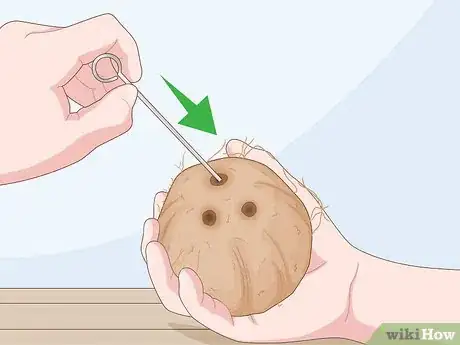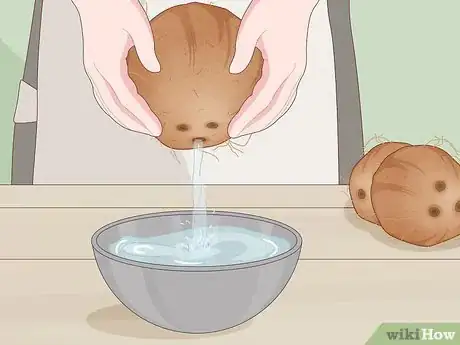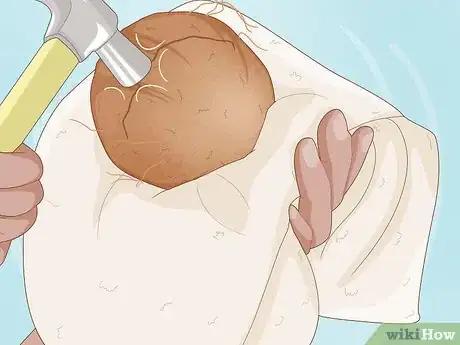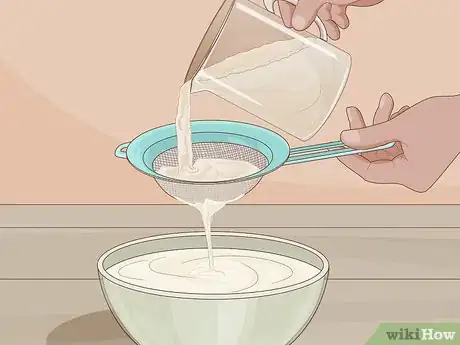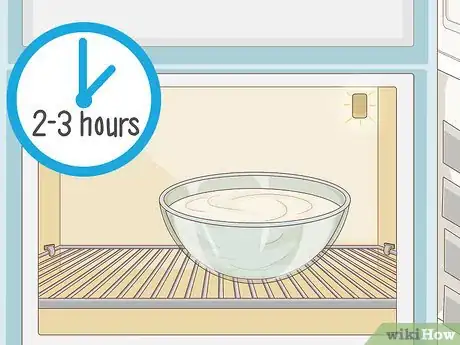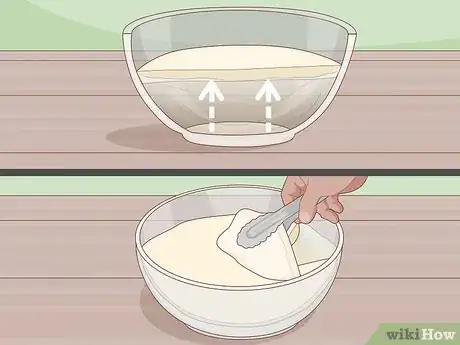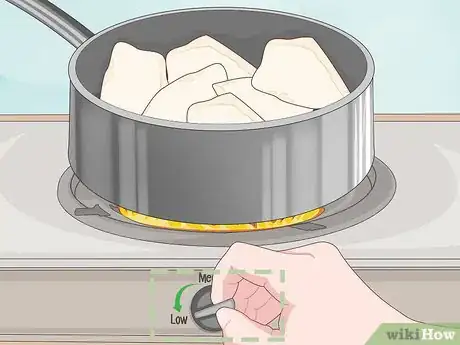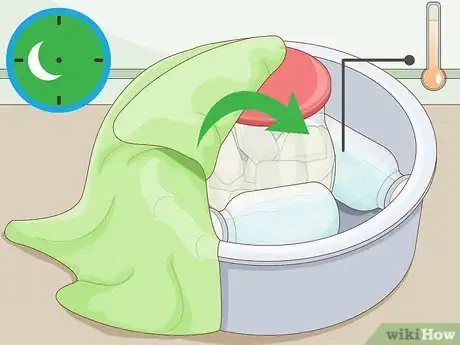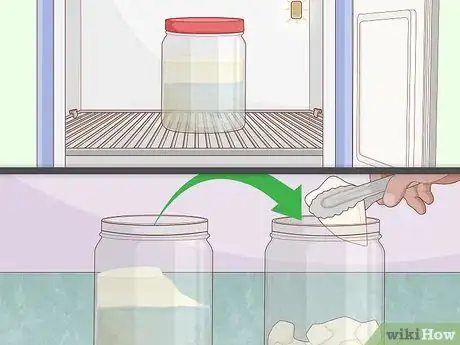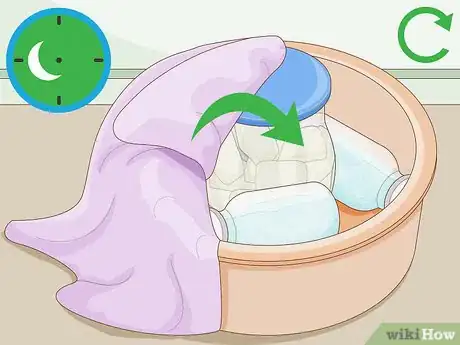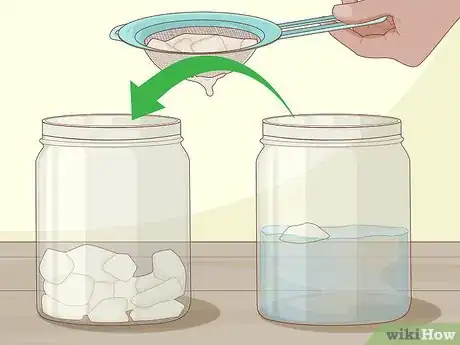This article was co-authored by wikiHow Staff. Our trained team of editors and researchers validate articles for accuracy and comprehensiveness. wikiHow's Content Management Team carefully monitors the work from our editorial staff to ensure that each article is backed by trusted research and meets our high quality standards.
There are 24 references cited in this article, which can be found at the bottom of the page.
This article has been viewed 17,429 times.
Learn more...
Coconut oil is great for cooking and many other uses. Making it at home can be time consuming and tricky, but you can do it with a bit of dedication! Start by removing the meat of the coconut from its shell. Then, use a blender to combine the meat with water and make coconut milk. From that, you can refine the oil using heat or a cold-press method.
Steps
Removing the Meat from the Shell
-
1Pierce the softest eye with a metal skewer. Poke at each of the coconut's 3 eyes. You should find one that's softer. When you do, push the skewer through the eye, making a hole through it.[1]
- The eyes are the small dark circles that are clustered together on the top of the coconut.
- You can also use a wooden skewer, but it could break. You could also try an ice pick or even just a sharp knife.[2]
-
2Pour the coconut water into a container. Turn the hole over a container and shake out the water. It may take a moment or two to get it all out; you should end up with 0.25 to 0.75 cups (59 to 177 mL) of coconut water from each coconut. If you need to, make the hole bigger.[3]
- Coconut water is good for drinking, and you won't really need it for the oil.
Advertisement -
3Whack the coconut with a hammer or meat tenderizer until it breaks. Grab the coconut with a towel and turn it so the shell is exposed. Tap the coconut with the tool, turning it as you do. The shell will eventually crack. Keep tapping to expand the crack around the coconut.[4]
- You can also use anything else heavy you have laying around, such as a small cast iron skillet or even a pestle. If you're using a skillet, set the coconut on a cutting board or another hard surface to crack it. You can also hit it on a hard surface.[5]
-
4Break the shell off the coconut by cracking it in pieces. Once the shell has cracked in the middle all the way around, the coconut should break in half. Place one half face-down on a cutting board, then whack the shell with the hammer or meat tenderizer. Just hitting it a few times should make the flesh loose enough to pull out.[6]
- Another option is to keep hitting it on a hard surface until the shell cracks off. Keep turning the shell to hit a new spot each time.[7]
-
5Remove the flesh and rinse the coconut. Use a butter knife to lever out the coconut flesh. Wash the coconut pieces under running water to remove any debris from the flesh.[8]
- Some people prefer to peel off the thin, brown skin, though it's not necessary. If you'd like to, use a vegetable peeler to take it off and rinse the pieces again.[9]
Using a Blender to Make Coconut Milk
-
1Chop the coconut meat into smaller pieces. Your blender will do most of the work for you, but your coconut meat needs to be in small enough bits for your blender to get to it. Try 1 inch (2.5 cm) cubes or smaller.[10]
- You can use as many or as few coconuts as you want. Keep in mind that it takes quite a few coconuts to make a small amount of oil and different methods will produce different amounts of oil. For instance, 3-4 coconuts will likely only produce 0.25 cups (59 mL) of coconut oil.
-
2Add the coconut pieces to a blender and pour in water. You may need to blend your coconut in batches if you're processing a lot of coconuts at once. Only fill the blender about 1/3 of the way with coconut. Pour in enough hot water to completely cover the coconut with an extra 1 inch (2.5 cm) or so of water on top.[11]
- Boil some water and then mix it with cool water so it's hot but not so hot that you can't touch it.
- Some people use cold water for extraction. However, you won't get as much oil from the coconut with cold water.[12]
-
3Pulse and blend the mixture until smooth. Place the lid on the blender. Push the "Pulse" button 3-4 times and then set it on high. Keep blending until it looks like it's a smooth, homogeneous mixture.[13]
- This process produces coconut milk.
-
4Strain the mixture through a sieve. Pour the coconut milk through a fine mesh sieve. As the mixture drains, use your hands to squeeze the pulp or chaff left behind to make sure you're getting all the milk out of it.[14]
- You may need to sieve it more than once to get all the chaff out.
- You can also use a nut milk bag, which is specifically made for making nut milks. It's made of fine cloth, and you can squeeze the whole bag to release the milk.[15]
- Alternatively, you can just use a piece of cheesecloth or muslin over a sieve, then pick up the chaff and cloth together to squeeze it out.
-
5Repeat the grinding process a second time to get all of the milk out. Put the chaff back in the blender with more water. Grind it again until it's smooth, and then pour it through the sieve. This will help release the rest of the coconut milk.[16]
- You can use the pulp or chaff in other dishes that call for coconut flakes.
-
6Place the milk in the refrigerator so the cream can rise to the top. Leave the coconut milk in the refrigerator for at least 2-3 hours. When it's ready, you'll see the coconut cream on the top in a hard crust.[17]
-
7Skim the coconut cream from the top of the container. Use a knife to gently slice through the coconut cream on top and run the knife around the edges. Pull the pieces of coconut cream off the top of the milk, doing your best to leave the rest of the milk behind.[18]
- You can cook rice or other foods in the liquid left behind, which will add more flavor to the food.
Cooking the Mixture to Separate the Oil from the Water
-
1Put the coconut cream in a pot over low heat. Don't let the mixture smoke, as you could burn the oil. Pick a stainless steel pot or something similar. Avoid using non-stick pans for this process.[19]
-
2Cook the coconut milk for at least an hour, stirring every 5-10 minutes. You will see the oil start to separate from the solids, which will be white at first. Over time, the water will boil off and the solids will start to turn brown. Once the solids are dark brown and the oil is completely separated, you're done with the cooking process.[20]
- Stir the mixture occasionally.
-
3Pour the mixture through cheesecloth, muslin, or a fine-mesh sieve. The sieve will remove the dark brown bits from the oil. Once the oil is clear, pour it into a container of your choice. Let it cool, then store it in the refrigerator or in your cupboard and use it in your favorite dishes.[21]
- Put it in a container that you can spoon it out from easily, as it will likely solidify.
Making Cold-Pressed Oil
-
1Put the coconut cream in a jar and keep it warm overnight. Add hot water bottles to the sides for warmth. You can place it in a cooler or put blankets over it to help keep it warm. This will begin the separation process, removing the water from the oil.[22]
-
2Place the jar in the refrigerator the next day to separate the cream. Check on it after a few hours. The cream will form a hard layer on top if it's separated. If it has, pull it from the refrigerator. Use a knife or spoon to scoop the hard part into a new jar.[23]
- You can discard the water or use it for cooking.
-
3Keep the mixture warm overnight again and then strain it. Place it back in the insulated area with hot water bottles. Once again, the curd will separate from the liquid below. In the morning, pull the jar out. Strain the mixture through cheesecloth and a metal strainer into a new jar.[24]
- Don't squeeze the curd during this process. Let it drip out.
-
4Refrigerate and separate the oil one more time. Leave the mixture in the refrigerator for at least a couple of hours. When it looks separated, pull the jar out. The hard part on top will be the oil. Use a knife or spoon to pull it out into a new jar, and you're finished with the oil.[25]
- It's best to refrigerate this kind of oil, as it's hard to get all of the water out. Water can spoil the oil.
Things You'll Need
Removing the Meat from the Shell
- Metal skewer or sharp knife
- Hammer, meat grinder, or hard surface
- Glass
- Butter knife
Using a Blender to Make Coconut Milk
- Sharp knife
- Blender
- Strainer
- Cheesecloth, muslin, or nut milk bag
- Bowl
Cooking the Mixture to Separate the Oil from the Water
- Pot
- Spoon
- Strainer
- Cheesecloth, muslin, or nut bag
- Container for the oil
Making Cold-Pressed Oil
- Knife
- Area to keep oil warm
- Jar
- Strainer
- Cheesecloth, muslin, or nut bag
- Container for the oil
- Spoon
References
- ↑ https://www.foodnetwork.com/grilling/summer-parties/photos/how-to-break-down-a-coconut
- ↑ https://www.youtube.com/watch?v=TMHksulmaQo&feature=youtu.be&t=11
- ↑ https://www.foodnetwork.com/grilling/summer-parties/photos/how-to-break-down-a-coconut
- ↑ https://www.foodnetwork.com/grilling/summer-parties/photos/how-to-break-down-a-coconut
- ↑ https://www.youtube.com/watch?v=TMHksulmaQo&feature=youtu.be&t=76
- ↑ https://www.foodnetwork.com/grilling/summer-parties/photos/how-to-break-down-a-coconut
- ↑ https://www.youtube.com/watch?v=TMHksulmaQo&feature=youtu.be&t=103
- ↑ https://www.youtube.com/watch?v=h95fAV-SdDQ&feature=youtu.be&t=49
- ↑ https://www.foodnetwork.com/grilling/summer-parties/photos/how-to-break-down-a-coconut
- ↑ https://www.youtube.com/watch?v=h95fAV-SdDQ&feature=youtu.be&t=57
- ↑ https://www.youtube.com/watch?v=h95fAV-SdDQ&feature=youtu.be&t=61
- ↑ https://www.youtube.com/watch?v=b1jF1BM58kY&feature=youtu.be&t=81
- ↑ https://www.youtube.com/watch?v=b1jF1BM58kY&feature=youtu.be&t=90
- ↑ https://www.youtube.com/watch?v=h95fAV-SdDQ&feature=youtu.be&t=88
- ↑ https://www.youtube.com/watch?v=b1jF1BM58kY&feature=youtu.be&t=111
- ↑ https://www.youtube.com/watch?v=h95fAV-SdDQ&feature=youtu.be&t=112
- ↑ https://www.youtube.com/watch?v=b1jF1BM58kY&feature=youtu.be&t=143
- ↑ https://www.youtube.com/watch?v=h95fAV-SdDQ&feature=youtu.be&t=158
- ↑ https://www.youtube.com/watch?v=h95fAV-SdDQ&feature=youtu.be&t=179
- ↑ https://www.youtube.com/watch?v=bsqdHKGgybs&feature=youtu.be&t=310
- ↑ https://www.youtube.com/watch?v=bsqdHKGgybs&feature=youtu.be&t=516
- ↑ https://www.youtube.com/watch?v=b1jF1BM58kY&feature=youtu.be&t=188
- ↑ https://www.youtube.com/watch?v=b1jF1BM58kY&feature=youtu.be&t=238
- ↑ https://www.youtube.com/watch?v=b1jF1BM58kY&feature=youtu.be&t=341
- ↑ https://www.youtube.com/watch?v=b1jF1BM58kY&feature=youtu.be&t=484
